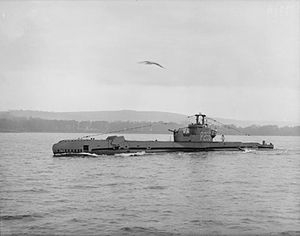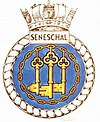HMS Seneschal was a S-class submarine of the third batch built for the Royal Navy during World War II. She survived the war and was sold for scrap in 1965.
 HMS Seneschal
| |
| History | |
|---|---|
| Name | HMS Seneschal |
| Builder | Scotts, Greenock |
| Laid down | 1 September 1943 |
| Launched | 23 April 1945 |
| Commissioned | 6 September 1945 |
| Fate | Sold for breaking up 1960 |
| Badge |  |
| General characteristics | |
| Class and type | S-class submarine |
| Displacement |
|
| Length | 217 ft (66.1 m) |
| Beam | 23 ft 9 in (7.2 m) |
| Draught | 14 ft 1 in (4.3 m) |
| Installed power |
|
| Propulsion |
|
| Speed |
|
| Range | 7,500 nmi (13,900 km; 8,600 mi) at 10 knots (19 km/h; 12 mph) surface; 120 nmi (220 km; 140 mi) at 3 knots (5.6 km/h; 3.5 mph) submerged |
| Test depth | 350 feet (106.7 m) |
| Complement | 48 |
| Armament |
|
Design and description
editThe last 17 boats of the third batch were significantly modified from the earlier boats. They had a stronger hull, carried more fuel and their armament was revised. The submarines had a length of 217 feet (66.1 m) overall, a beam of 23 feet 9 inches (7.2 m) and a draft of 14 feet 1 inch (4.3 m). They displaced 814 long tons (827 t) on the surface and 990 long tons (1,010 t) submerged.[1] The S-class submarines had a crew of 48 officers and ratings. They had a diving depth of 350 feet (106.7 m).[2]
For surface running, the boats were powered by two 950-brake-horsepower (708 kW) diesel engines, each driving one propeller shaft. When submerged each propeller was driven by a 650-horsepower (485 kW) electric motor.[3] They could reach 14.75 knots (27.32 km/h; 16.97 mph) on the surface and 9 knots (17 km/h; 10 mph) underwater.[1] On the surface, the third batch boats had a range of 7,500 nautical miles (13,900 km; 8,600 mi) at 10 knots (19 km/h; 12 mph) and 120 nmi (220 km; 140 mi) at 3 knots (5.6 km/h; 3.5 mph) submerged.[2]
Seneschal was armed with six 21 inch (533 mm) torpedo tubes in the bow. She carried six reload torpedoes for a grand total of a dozen torpedoes. Twelve mines could be carried in lieu of the torpedoes. The boat was also equipped with a 4-inch (102 mm) deck gun.[1]
Construction and career
editHMS Seneschal was built by Scotts, of Greenock and launched on 23 April 1945. So far she has been the only ship of the Royal Navy to bear the name Seneschal, after the office. She survived the Second World War, but endured several mishaps in post-war life. She suffered an explosion on 4 June 1947, and on 14 June 1952, she collided with the Danish frigate Thetis, south of the Isle of Wight. The submarine's periscope and radar mast were damaged.[4] In 1953 she took part in the Fleet Review to celebrate the Coronation of Queen Elizabeth II.[5] She was eventually sold, arriving at the yards of Clayton & Davie, Dunston, for breaking up on 23 August 1960.
Notes
editReferences
edit- Akermann, Paul (2002). Encyclopaedia of British Submarines 1901–1955 (reprint of the 1989 ed.). Penzance, Cornwall: Periscope Publishing. ISBN 1-904381-05-7.
- Bagnasco, Erminio (1977). Submarines of World War Two. Annapolis, Maryland: Naval Institute Press. ISBN 0-87021-962-6.
- Chesneau, Roger, ed. (1980). Conway's All the World's Fighting Ships 1922–1946. Greenwich, UK: Conway Maritime Press. ISBN 0-85177-146-7.
- Colledge, J. J.; Warlow, Ben (2006) [1969]. Ships of the Royal Navy: The Complete Record of all Fighting Ships of the Royal Navy (Rev. ed.). London: Chatham Publishing. ISBN 978-1-86176-281-8.
- McCartney, Innes (2006). British Submarines 1939–1945. New Vanguard. Vol. 129. Oxford, UK: Osprey. ISBN 1-84603-007-2.